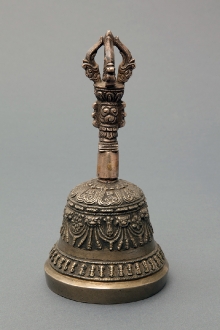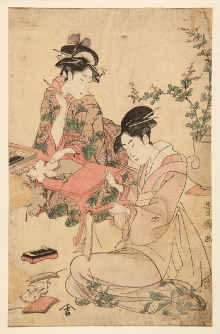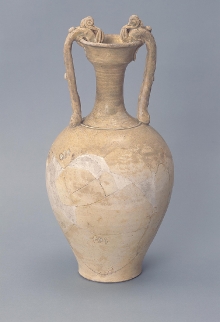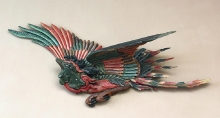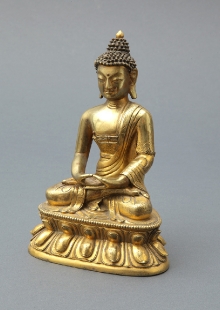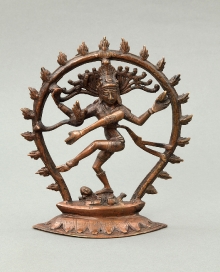The Asian collection amounts to ca. 500 objects. Part of them are the remains of pre-war German collections. This group includes wooden full-scale statues with remains of gilding and polychromy. They originate from China and date back to the 17th and 18th centuries. Noteworthy among them are statues of Buddha Vairocana and Amoghasiddhi, Bodhisattva Guanyin or Jin Tongzi in adoration pose, inside which numerous votive offerings with inscriptions were found. Other objects from former German collections, that have survived to our times, are parts of Samurai armours, stone and clay Tang dynasty (China) figures and Batak chronicle from Sumatra.
After the war the Museum started to collect objects related to Eastern religions, mainly Hinduism and Buddhism. They were, the most frequently, exhibits bought from Desa antique shops and individuals. This way brought several dozens of statuettes of wood, bronze and brass originating from China, Tibet, Mongolia, Vietnam, Laos, Cambodia and India dated to the 19th century or the turn of the 19th and the 20th centuries, presenting deities related to Hinduism (e.g. Shiva, Ganesha) and Buddhism (presentations of Buddha and Bodhisattvas).
The Museum has also obtained a collection of thangkas and tsakli – Tibetan religious pictures from the turn of the 19th and 20th centuries and other ceremonial items (e.g. vajras, damaru drum and prayer wheel with mantra written on its outside).
Beside sacred objects, a number of porcelain vessels, woodcuts from China and Japanese ukiyo-e were also purchased. An interesting collection was obtained from individuals. It includes nine Japanese tsubas from Edo period (17th - 19th centuries) and 31 katagami of various types (jizomari, jishiro, kojishiro) dated to the second half of the 19th century, illustrating the beauty of Japansese flora and fauna.
The Museum collects also strictly ethnographical objects. In early 1970s several dozens of objects from Nepal were donated by Jacek Łapott. The Museum obtained: kukri, Indian talwar sabres, masks, clay votive offerings and funeral statuettes.
In 1976 the Museum received another donation: the crew of s/y Zew Morza, flag yacht of Polish Yachting Association, donated over a dozen of objects from Timor island in South-Eastern Asia to the Department of Non-European Cultures. Beside clay vessels, coral anchors and outriggers the Museum obtained also an outrigger dugout boat.
Noteworthy objects in the ethnographical collection are those purchased in 1981 from Maria Wrońska-Friend, being examples of material culture of Ifugao people from Luzon island in Philippines. The Museum collection was enriched by gamong and binod textiles, clay vessels, woven wares, tools and weapons.
In 1989 the Museum obtained other examples of weapons, from Indonesian Lombok island. They were 11 pieces of malee weapons (e.g. kris and dusacks with silver inlaid) from middle 19th century.
- Młynek modlitewny, Tybet, 1. połowa XIX w., kość, brąz, pergamin, emalia, wys. 21,4 cm, fot. G. Solecki, A. Piętak
- Author: No Data
- Buddyjski dzwonek rytualny, Mongolia, XIX w., brąz, srebro, żelazo, wys. 15,7 cm, fot. G. Solecki, A. Piętak
- Author: No Data
- Ukiyo-e, drzeworyt barwny, autor: Utagawa Toyokuni (1769-1825) lub artysta należący do tej samej szkoły (Utagawa), Japonia, XVIII-XIX w., 37,6 x 24,2 cm, fot. G. Solecki, A. Piętak
- Author: No Data
- Amfora z uchwytami w kształcie smoków, Chiny, dyn. Tang (618-906), glina, częściowo polewana, wys. 40,7 cm, fot. G. Solecki, A. Piętak
- Author: No Data
- Dzwon, Chiny, dyn. Zhou, 1150-480 p.n.e., brąz, 28,5 x 21 cm, fot. G. Solecki, A. Piętak
- Author: No Data
- Budda Amoghasiddhi, Chiny, XVII w., drewno, złocenia, 110 x 81 cm, fot. G. Solecki, A. Piętak
- Author: No Data
- Tanka, Tybet, przełom XIX i XX w., tempera, płótno, 48 x 34 cm, fot. G. Solecki, A. Piętak
- Author: No Data
- Feniks, Japonia, XVI w., drewno polichromowane, 140 x 260 cm, fot. G. Solecki, A. Piętak
- Author: No Data
- Budda Amitabha, Mongolia, XIX w., odlew z brązu, 17,5 x 11 x 7,5 cm, fot. G. Solecki, A. Piętak
- Author: No Data


